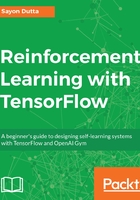
Asynchronous advantage actor-critic
The A3C algorithm was published in June 2016 by the combined team of Google DeepMind and MILA. It is simpler and has a lighter framework that used the asynchronous gradient descent to optimize the deep neural network. It was faster and was able to show good results on the multi-core CPU instead of GPU. One of A3C's big advantages is that it can work on continuous as well as discrete action spaces. As a result, it has opened the gateway for many new challenging problems that have complex state and action spaces.
We will discuss it at a high note here, but we will dig deeper in Chapter 6, Asynchronous Methods. Let's start with the name, that is, asynchronous advantage actor-critic (A3C) algorithm and unpack it to get the basic overview of the algorithm:
- Asynchronous: In DQN, you remember we used a neural network with our agent to predict actions. This means there is one agent and it's interacting with one environment. What A3C does is create multiple copies of the agent-environment to make the agent learn more efficiently. A3C has a global network, and multiple worker agents, where each agent has its own set of network parameters and each of them interact with their copy of the environment simultaneously without interacting with another agent's environment. The reason this works better than a single agent is that the experience of each agent is independent of the experience of the other agents. Thus, the overall experience from all the worker agents results in diverse training.
- Actor-critic: Actor-critic combines the benefits of both value iteration and policy iteration. Thus, the network will estimate both a value function, V(s), and a policy, π(s), for a given state, s. There will be two separate fully-connected layers at the top of the function approximator neural network that will output the value and policy of the state, respectively. The agent uses the value, which acts as a critic to update the policy, that is, the intelligent actor.
- Advantage: Policy gradients used discounted returns telling the agent whether the action was good or bad. Replacing that with Advantage not only quantifies the the good or bad status of the action but helps in encouraging and discouraging actions better(we will discuss this in Chapter 4, Policy Gradients).